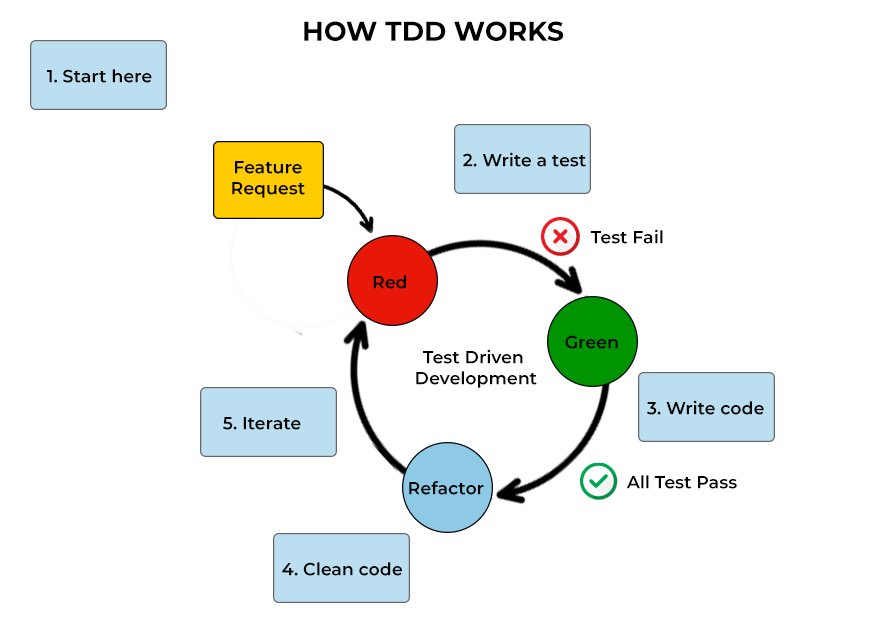Test-Driven Development (TDD) in SDET: Pros and Cons

In the discipline of Software Development Engineering and Testing SDET, Test-Driven Development (TDD) is a crucial technique. It is a development methodology that places a strong emphasis on creating automated tests prior to generating actual code.
Due to its many benefits, this strategy has become very popular, but it also has some disadvantages. The advantages and disadvantages of test-driven development in SDET will be discussed in this article. Wedevx.co is one of the best teams in the USA. you can get the free consultation from the team.
Introduction to Test-Driven Development
In the iterative software development process known as test-driven development (TDD), developers first construct automated tests before implementing the code necessary to pass those tests. It uses a straightforward but effective cycle called Red-Green-Refactor. Creating a failed test is represented by the “Red” phase, creating the simplest possible code to pass the test is represented by the “Green” phase, and improving the code without altering its behavior is represented by the “Refactor” phase.
The Test-Driven Development Process
The following steps are commonly included in the test-driven development process:
- Write a Test: Test Architects create a test that outlines the desired behavior of the code is the first stage. Since the code has not yet been put into use, this test should initially fail.
- Write Minimal Code: The following step is to write the barest minimum of code necessary to pass the test. Making the test pass is the main priority, not producing the best or most complete code.
- Refactor the Code: After the test is successful, the code needs to be refactored. Refactoring entails enhancing the code’s general quality, removing redundant code, and improving the design.
- Repeat: Write more tests and repeat the pattern of writing minimal code and reworking to keep going until the desired functionality is achieved.
Advantages of Test-Driven Development in SDET
Increased Test Coverage
The fact that TDD encourages greater test coverage is one of its key advantages. Developers are compelled to consider every scenario and edge case by building tests before writing the code. This guarantees rigorous testing of the code and lessens the possibility of errors seeping through the cracks.
Early Bug Detection
TDD allows for early bug detection. By writing tests upfront, developers can quickly identify issues or defects in their code. Since failing tests signal a problem, developers can address the bugs early in the development process, making them easier and cheaper to fix.
Improved Code Quality
Test Architects promote writing modular, loosely coupled, and easily testable code. The process of writing tests first encourages developers to focus on the code’s design and architecture. As a result, the code tends to be more maintainable, readable, and less prone to bugs. So, whether you’re developing the software in-house or outsourcing the process to nearshore software development companies consider adopting a test-driven development (TDD) approach.
Anyone can get the free consultation by clicking on this mentioned link devx.
Enhanced Collaboration
TDD fosters collaboration between developers and testers. By having tests as a common reference point, developers and testers can better understand the requirements and expected behavior of the code in SDET. This leads to improved communication, fewer misunderstandings, and ultimately, a better end product.

Disadvantages of Test-Driven Development in SDET
Time and Effort
TDD implementation necessitates an initial time and effort commitment. The development process may initially be slowed down by writing tests before writing the code. Striking the correct balance between testing and coding and becoming adept at designing good tests takes discipline and practice.
Learning Curve
TDD entails a paradigm shift in how software engineers approach the process. It necessitates a shift in perspective and a solid command of testing methodologies. SDET Developers that are new to TDD may have a difficult time adjusting and may face a long learning curve.
Initial Overhead
Writing tests before writing code can initially result in more work being done. When working on small or straightforward projects, where the advantages of TDD might not be immediately obvious, this can be especially striking as an SDET. As the software expands and the advantages of thorough testing are realized, the overhead can be reduced over time.
Unrealistic Test Scenarios
Making tests based on anticipated behavior is a key component of TDD. There might be circumstances, nevertheless, in which it is difficult to specify the intended behavior in advance. This may be especially true for initiatives that are complex or changing quickly. In these situations, rigidly following TDD principles could lead to tests that are impractical or insufficient.
Conclusion
Test-Driven Advancement (TDD) carries critical benefits to the field of Programming Improvement Designing and Testing (SDET). It advances expanded test inclusion, early bug recognition, further developed code quality, and upgraded coordinated effort. In any case, it likewise presents difficulties, for example, time and exertion speculation, an expectation to learn and adapt, beginning above, and the requirement for practical test situations. Likewise, with any improvement approach, the choice to take on TDD ought to be founded on the particular necessities and requirements of the task. Discover more topics and helpful guides on our blog.
FAQs
While TDD can be useful for most programming projects, its appropriateness relies upon variables like undertaking intricacy, group skill, and time imperatives. Assessing the venture necessities prior to choosing to take on TDD is significant.
Test Architects altogether lessen the number of bugs by advancing early bug identification. Notwithstanding, it can’t be ensured without bug programming. TDD is a device to further develop code quality and decrease surrenders, yet it ought to be enhanced with other testing strategies.
At first, TDD can somewhat expand the improvement time spans because of the extra exertion expected to compose tests. Nonetheless, over the long haul, TDD can help distinguish and fix messes ahead of schedule, prompting quicker advancement cycles and more limited troubleshooting stages.
To execute TDD in SDET successfully, designers ought to have a strong comprehension of testing methods, experience with the improved system and devices, and the capacity to compose spotless and viable code.
Indeed, TDD can be incorporated with other programming advancement procedures, for example, Coordinated or Scrum. TDD supplements these philosophies by giving an efficient way to deal with testing and code improvement.


